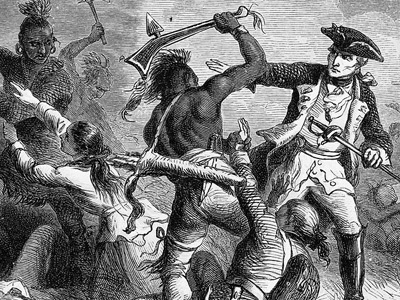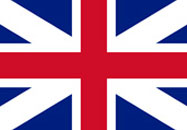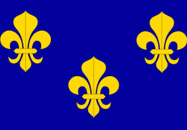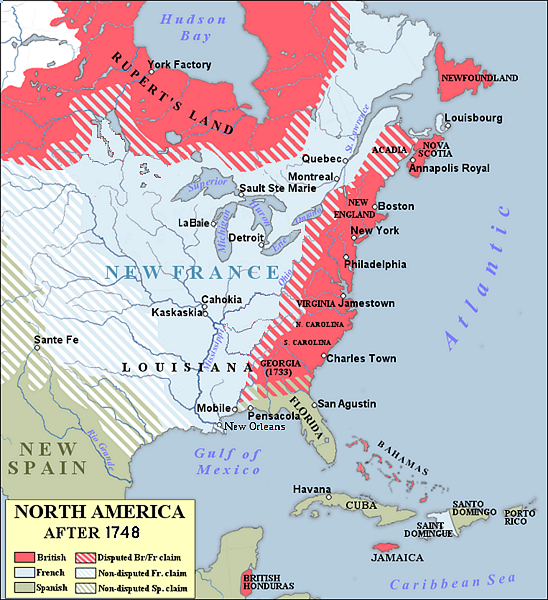French and Indian War (1754–1763)
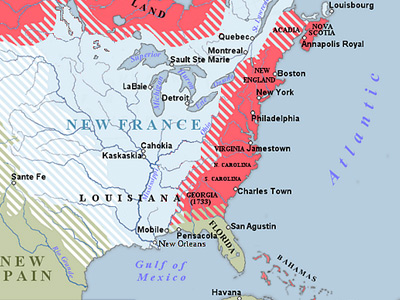
French Victories 1756–1757
Following the death of Braddock, William Shirley assumed command of British forces in North America. At a meeting in Albany in December 1755, he laid out his plans for 1756. In addition to renewing the efforts to capture Niagara, Crown Point and Duquesne, he proposed attacks on Fort Frontenac on the north shore of Lake Ontario and an expedition through the wilderness of the Maine district and down the Chaudière River to attack the city of Quebec. Bogged down by disagreements and disputes with others, including William Johnson and New York's Governor Sir Charles Hardy, Shirley's plan had little support.
Newcastle replaced him in January 1756 with Lord Loudoun, with Major General James Abercrombie as his second in command. Neither of these men had as much campaign experience as the trio of officers France The Kingdom of France is the historiographical name or umbrella term given to various political entities of France in the medieval and early modern period. It was one of the most powerful states in Europe since the High Middle Ages. It was also an early colonial power, with possessions around the world. Colonial conflicts with Great Britain led to the loss of much of its North American holdings by 1763. The Kingdom of France adopted a written constitution in 1791, but the Kingdom was abolished a year later and replaced with the First French Republic. sent to North America. French regular army reinforcements arrived in New France in May 1756, led by Major General Louis-Joseph de Montcalm and seconded by the Chevalier de Lévis and Colonel François-Charles de Bourlamaque, all experienced veterans from the War of the Austrian Succession. During that time in Europe, on May 18, 1756, England formally declared war on France, which expanded the war into Europe, which was later to be known as the Seven Years' War.
The Kingdom of France is the historiographical name or umbrella term given to various political entities of France in the medieval and early modern period. It was one of the most powerful states in Europe since the High Middle Ages. It was also an early colonial power, with possessions around the world. Colonial conflicts with Great Britain led to the loss of much of its North American holdings by 1763. The Kingdom of France adopted a written constitution in 1791, but the Kingdom was abolished a year later and replaced with the First French Republic. sent to North America. French regular army reinforcements arrived in New France in May 1756, led by Major General Louis-Joseph de Montcalm and seconded by the Chevalier de Lévis and Colonel François-Charles de Bourlamaque, all experienced veterans from the War of the Austrian Succession. During that time in Europe, on May 18, 1756, England formally declared war on France, which expanded the war into Europe, which was later to be known as the Seven Years' War.

These books are available for download with Apple Books on your Mac or iOS device
Governor Vaudreuil, who harboured ambitions to become the French commander in chief (in addition to his role as governor), acted during the winter of 1756 before those reinforcements arrived. Scouts had reported the weakness of the British supply chain, so he ordered an attack against the forts Shirley had erected at the Oneida Carry. In the March Battle of Fort Bull, French forces destroyed the fort and large quantities of supplies, including 45,000 pounds of gunpowder. They set back any British The Kingdom of Great Britain was a sovereign country in Western Europe from 1 May 1707 to the end of 31 December 1800. The state was created by the 1706 Treaty of Union and ratified by the Acts of Union 1707, which united the kingdoms of England (which included Wales) and Scotland to form a single kingdom encompassing the whole island of Great Britain and its outlying islands, with the exception of the Isle of Man and the Channel Islands. hopes for campaigns on Lake Ontario, and endangered the Oswego garrison, already short on supplies. French forces in the Ohio valley also continued to intrigue with Indians throughout the area, encouraging them to raid frontier settlements. This led to ongoing alarms along the western frontiers, with streams of refugees returning east to get away from the action.
The Kingdom of Great Britain was a sovereign country in Western Europe from 1 May 1707 to the end of 31 December 1800. The state was created by the 1706 Treaty of Union and ratified by the Acts of Union 1707, which united the kingdoms of England (which included Wales) and Scotland to form a single kingdom encompassing the whole island of Great Britain and its outlying islands, with the exception of the Isle of Man and the Channel Islands. hopes for campaigns on Lake Ontario, and endangered the Oswego garrison, already short on supplies. French forces in the Ohio valley also continued to intrigue with Indians throughout the area, encouraging them to raid frontier settlements. This led to ongoing alarms along the western frontiers, with streams of refugees returning east to get away from the action.
The new British command was not in place until July. When he arrived in Albany, Abercrombie refused to take any significant actions until Loudoun approved them. Montcalm took bold action against his inertia. Building on Vaudreuil's work harassing the Oswego garrison, Montcalm executed a strategic feint by moving his headquarters to Ticonderoga, as if to presage another attack along Lake George. With Abercrombie pinned down at Albany, Montcalm slipped away and led the successful attack on Oswego in August. In the aftermath, Montcalm and the Indians under his command disagreed about the disposition of prisoners' personal effects. The Europeans did not consider them prizes and prevented the Indians from stripping the prisoners of their valuables, which angered the Indians.

Montcalm trying to stop allied Native Americans from attacking British soldiers and civilians as they leave after the Battle of Fort William Henry

Montcalm trying to stop allied Native Americans from attacking British soldiers and civilians as they leave after the Battle of Fort William Henry.
( Click image to enlarge)
Loudoun, a capable administrator but a cautious field commander, planned one major operation for 1757: an attack on New France's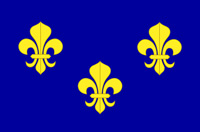 New France was the territory colonized by France in North America, beginning with the exploration of the Gulf of Saint Lawrence by Jacques Cartier in 1534 and ending with the cession of New France to Great Britain and Spain in 1763 under the Treaty of Paris. In the 16th century, the lands were used primarily to draw from the wealth of natural resources such as furs through trade with the various indigenous peoples. In the seventeenth century, successful settlements began in Acadia and in Quebec. capital, Quebec. Leaving a sizable force at Fort William Henry to distract Montcalm, he began organizing for the expedition to Quebec. He was then ordered by William Pitt, the Secretary of State responsible for the colonies, to attack Louisbourg first. Beset by delays of all kinds, the expedition was finally ready to sail from Halifax, Nova Scotia in early August. In the meantime French ships had escaped the British blockade of the French coast, and a fleet outnumbering the British one awaited Loudoun at Louisbourg. Faced with this strength, Loudoun returned to New York amid news that a massacre had occurred at Fort William Henry.
New France was the territory colonized by France in North America, beginning with the exploration of the Gulf of Saint Lawrence by Jacques Cartier in 1534 and ending with the cession of New France to Great Britain and Spain in 1763 under the Treaty of Paris. In the 16th century, the lands were used primarily to draw from the wealth of natural resources such as furs through trade with the various indigenous peoples. In the seventeenth century, successful settlements began in Acadia and in Quebec. capital, Quebec. Leaving a sizable force at Fort William Henry to distract Montcalm, he began organizing for the expedition to Quebec. He was then ordered by William Pitt, the Secretary of State responsible for the colonies, to attack Louisbourg first. Beset by delays of all kinds, the expedition was finally ready to sail from Halifax, Nova Scotia in early August. In the meantime French ships had escaped the British blockade of the French coast, and a fleet outnumbering the British one awaited Loudoun at Louisbourg. Faced with this strength, Loudoun returned to New York amid news that a massacre had occurred at Fort William Henry.
French irregular forces (Canadian scouts and Indians) harassed Fort William Henry throughout the first half of 1757. In January they ambushed British rangers near Ticonderoga. In February they launched a daring raid against the position across the frozen Lake George, destroying storehouses and buildings outside the main fortification. In early August, Montcalm and 7,000 troops besieged the fort, which capitulated with an agreement to withdraw under parole. When the withdrawal began, some of Montcalm's Indian allies, angered at the lost opportunity for loot, attacked the British column, killing and capturing several hundred men, women, children, and slaves. The aftermath of the siege may have contributed to the transmission of smallpox into remote Indian populations; as some Indians were reported to have traveled from beyond the Mississippi to participate in the campaign and returned afterward having been exposed to European carriers.
HISTORY
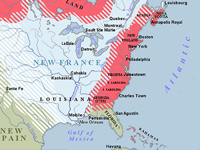
RESOURCES
This article uses material from the Wikipedia article "French and Indian War", which is released under the Creative Commons Attribution-Share-Alike License 3.0.
© Stories Preschool. All Rights Reserved.
